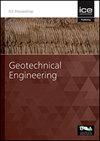Preliminary study on tensile performance of 3D-printed geogrids- effects of various geometrical configurations
IF 1.7
4区 工程技术
Q3 ENGINEERING, GEOLOGICAL
Proceedings of the Institution of Civil Engineers-Geotechnical Engineering
Pub Date : 2024-02-29
DOI:10.1680/jgeen.23.00068
引用次数: 0
Abstract
This study aims to evaluate the tensile performance of additively manufactured polyethylene terephthalate glycol (PETG) geogrids 3d printed using the material extrusion technique. The ‘Creality Ender-3 V-2‘ 3D printer was employed for this purpose. Subsequently, specimens were subjected to loading at a rate of 1 mm/min until failure occurred. The geometrical parameters investigated in this study included: (1) shape of the aperture (square, triangular, hexagonal), (2) aperture size, (3) rib thickness, and (4) type of junction. The results revealed that the failure of specimens was primarily brittle and independent of any specific geometrical configuration or modifications. The initiation of failure consistently originated from the junctions. Among specimens with typical junctions, the triaxial geogrids exhibited the highest tensile capacity, while among geogrids with modified junctions, the square geogrids performed the best. Additionally, the load capacity of geogrids was primarily governed by linear behaviour in terms of rib width, regardless of aperture size or shape whereas nonlinear regression model characterized the load-displacement curves. Finally, it is important to account for geometrical nonlinearity in specimens with hexagonal apertures.三维打印土工格栅拉伸性能初步研究--各种几何结构的影响
本研究旨在评估使用材料挤压技术 3D 打印的添加式制造聚对苯二甲酸乙二醇(PETG)土工格栅的拉伸性能。为此使用了 "Creality Ender-3 V-2 "三维打印机。随后,以 1 毫米/分钟的速度对试样进行加载,直至发生破坏。本研究调查的几何参数包括(1) 孔形状(正方形、三角形、六边形);(2) 孔尺寸;(3) 肋厚度;(4) 结点类型。结果表明,试样的破坏主要是脆性破坏,与任何特定的几何结构或修改无关。失效的起始点始终源于连接处。在具有典型接合点的试样中,三轴土工格栅的抗拉能力最高,而在具有改良接合点的土工格栅中,方形土工格栅的性能最好。此外,无论孔径大小或形状如何,土工格栅的承载能力主要受肋宽线性行为的制约,而非线性回归模型则描述了载荷-位移曲线的特征。最后,必须考虑六边形孔径试样的几何非线性。
本文章由计算机程序翻译,如有差异,请以英文原文为准。
求助全文
约1分钟内获得全文
求助全文
来源期刊
CiteScore
4.40
自引率
4.50%
发文量
68
审稿时长
3 months
期刊介绍:
Geotechnical Engineering provides a forum for the publication of high quality, topical and relevant technical papers covering all aspects of geotechnical research, design, construction and performance. The journal aims to be of interest to those civil, structural or geotechnical engineering practitioners wishing to develop a greater understanding of the influence of geotechnics on the built environment.

 求助内容:
求助内容: 应助结果提醒方式:
应助结果提醒方式:


